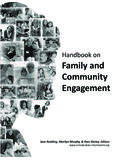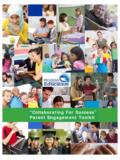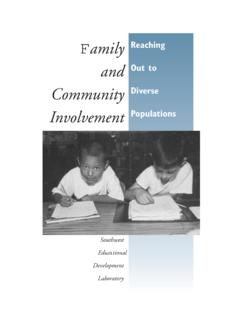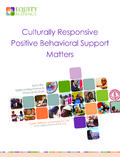Transcription of Parenting: Promote and Foster 2. Communicating: …
1 What Research Says About family - school - community Partnerships Prepared for the Colorado Department of Education The Epstein model of Six Types of Involvement provides a framework to review research that ties family and community involvement in schools to positive student outcomes. Developed by Joyce Epstein, PhD, of Johns Hopkins University, this research-based model emphasizes the importance of recognizing three overlapping spheres of influence on student development. family , school and community can collaborate in six key ways to Foster a caring community that children need to maximize their potential in school and in later The Epstein model is the basis for the National Standards for Parent/ family Involvement developed by the National PTA and the National Coalition for Parent Involvement.
2 The Colorado Department of Education Prevention Initiatives utilized this model to help schools take a comprehensive approach to Promote meaningful parent and community involvement in schools. Each section below looks at a type of involvement, offers a review of relevant research, and concludes with examples of activities and approaches implemented in Colorado schools.* 1. Parenting: Promote and Foster Parenting Skills to Develop Home Environments That Support Children As Students Children spend 70% of their waking hours (including weekends and holidays) outside of Thus, the power of out-of- school time is significant.
3 Research shows that the quality of home environments strongly correlates with students academic achievement and school A comprehensive learning home environment includes high parental aspirations and expectations, a rich language environment, academic support and guidance, and stimulation (opportunities to explore new ideas).4 Studies demonstrate that effective programs can teach parents how to create a home environment that provides support and encouragement appropriate for their children s developmental , 6, 7 Examples from Colorado Schools: Many schools host parenting classes such as Love and Logic, Nurturing Parent, and Los Padres/Los Madres.
4 A few schools offer a lending library that provides educational materials to parents and family members. 2. Communicating: Establish Regular and Meaningful Two-Way Communication Between Home and school Studies show that creating home- school partnerships based on two-way communication enhances the parental involvement critical to children s academic Communication stressing student achievement rather than problems-centered discussions creates a more positive and open dialogue between parents and school Families feel empowered as connected members of the school community when schools create welcoming outreach activities and Example from Colorado Schools.
5 The most common methods of communication include: school newsletters/papers, calendars, fliers, school handbooks, school /parent compacts, and websites. Often newsletters contain information for families and are translated into other languages. Over 120 Colorado school districts have websites and several include a family and community page. In addition, schools host Back-to- school events and school socials, have automated phone calling systems, and mass email announcements. school marquee signs are frequently used to announce events, activities and resources available at the school .
6 3. Volunteering: Welcome, Value and Recruit Parental Support and Assistance in school Activities Research shows that parent volunteering can have a significant impact on students achievement in mathematics, reading, and school programs that train parents to develop skills to become more meaningful members of the school community are especially Parents enhance their own self esteem both as role models, teachers, and learners in the Example of Colorado Schools: Several school districts have formal volunteer programs. Many schools recruit volunteers for the following positions: parent/guardian representative on school decision-making teams, field trip helper, classroom assistant, tutor, coach, fundraiser, and playground monitor.
7 community groups also volunteer their time to present workshops and classes. Some schools provide gathering area/space for volunteers and parents. 4. Learning at Home: Families/Parents Play an Integral Role in Assisting Student Learning Research indicates that when schools work together with families to support learning, children tend to succeed not just in school , but throughout Both parents and teachers need specific information, programs, and training to Foster constructive family involvement in children s Effective school outreach encourages three types of parental involvement with their children at home that consistently relate to academic achievement.
8 (1) organizing and monitoring children s time, especially television viewing, (2) assisting with homework and (3) discussing school -related activities and future educational Examples from Colorado Schools: Several schools offer concrete suggestions on how to help children with their studies by including homework tips in newsletters, hosting family events, and offering accessible tutoring and homework help. Some communities host school supply giveaways and have lending libraries. 5. school Decision Making: Include Parents in school Decisions and Develop Parent Leaders and Representatives Studies indicate that four roles played by parents can contribute to children s learning: (1) parents as teachers (2) supporters (3) advocates and (4) decision Effective programs encourage parents to become actively involved in the decision making and governance structure of the school .
9 This involvement helps develop positive partnerships between parents and school staff. As a result, student achievement and attendance, as well as parents self esteem, can Examples from Colorado Schools: In compliance with legislative mandates, parents serve on school advisory councils, school accountability teams, and governance committees. All Title I schools are required to adopt a policy on parent involvement and to agree with parents upon a school /parent compact. It is recommended that the roles and responsibilities of parent/ community leaders on committees be well-defined and reflected in job descriptions.
10 Schools have facilitated parent/ family / community participation by providing childcare during meetings and holding meetings at convenient times for parents. 6. Collaborating with the community : Identify and Use community Resources and Services to Strengthen Schools, Families, and Student Learning and Development Although children s school - community link is the least supported and publicized component of the school - family - community partnership model,19 research indicates that the quality of those connections influences children s school Effective partnerships are based on understanding the cultural, socioeconomic, health, social, and recreational needs and interests of each school s families.





